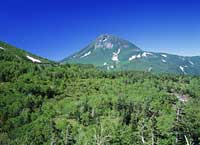|
|
|||||||
|
|
|||||||
|
|||||||
| | Web Japan >> | Trends in Japan >> | Science & Technology >> | Hokkaido Heritage | |
|
HOKKAIDO HERITAGE UNESCO Designates Shiretoko a World Heritage Site (August 22, 2005) Jutting into the Sea of Okhotsk like a crooked finger, Shiretoko is a peninsula of dense pristine forest that is home to a wide variety of fauna and flora and is ringed by dramatic, sheer cliffs. Located in the northeast of Hokkaido, the northernmost island of Japan, the area's spectacular scenery and state of preservation so impressed UNESCO that in July it put Shiretoko on its World Heritage list. The peninsula is the third natural site in Japan to obtain the designation, after Yakushima Island in Kagoshima Prefecture and the Shirakami Mountain Range in Aomori and Akita prefectures. Pristine Peninsula In the language of the Ainu, the native people of Hokkaido, Shiretoko means "land's end." The peninsula was created by lava flows and erosion by drift ice. Its environment has remained pristine thanks to its foreboding cliffs, which have prevented human encroachment. From the shoreline to the tall mountains inland, the area contains an amazing variety of geographical features and supports a wide variety of animals and plants in its diverse eco-system. Shiretoko's rivers contain trout and salmon swimming upstream to spawn, while brown bears and owls inhabit the forests. The area is the world's busiest wintering spot for sea eagles and is also an important breeding ground for seals. The surrounding ocean is a trove of marine life, due to the vast amounts plankton that grow under the drift ice. The peninsula is the most southerly point in the northern hemisphere where drift ice is found. When UNESCO issued its designation, it described the peninsula as "an outstanding example of the interaction of marine and terrestrial ecosystems as well as extraordinary ecosystem productivity largely influenced by the formation of seasonal ice at the lowest latitude in the northern hemisphere. . . . The site is globally important for threatened sea birds and migratory birds, a number of salmonid species, and for a number of marine mammals, including the Steller's sea lion, and some cetacean species." Keeping Humans at Bay Quite a few tourists came to visit in the following years. Now the travel industry hopes to use the area's World Heritage designation to attract larger numbers of both Japanese and foreign visitors to the peninsula. Travel agencies are planning group tours to the region. Overseas tourists are also being targeted, an effort that has been made easier by Expo 2005 in Aichi Prefecture, where the peninsula's natural wonders are being promoted. Plans are afoot, for example, to attract bird watchers from Europe and tourists from Southeast Asia and other countries with warm climates to come to witness the drift ice. Other initiatives involve harvesting some of the region's abundant marine resources. A seafood processing company in Rausu, a town in the Shiretoko area, is selling a seafood hamper featuring five types of local fish and shellfish. A portion of the profits is donated to the local community. Products made from local salmon or deepsea water are also being developed and promoted. When UNESCO selected the area, it advised that its marine and other areas remain preserved. Shiretoko now faces the challenge of balancing the increased tourism that will accompany its newfound fame with environmental preservation. Copyright (c) 2005 Web Japan. Edited by Japan Echo Inc. based on domestic Japanese news sources. Articles presented here are offered for reference purposes and do not necessarily represent the policy or views of the Japanese Government. |
A NEW WORLD HERITAGE SITE (November 16, 2004) HEAVENLY HOKKAIDO (June 2, 2003) |
|
|



